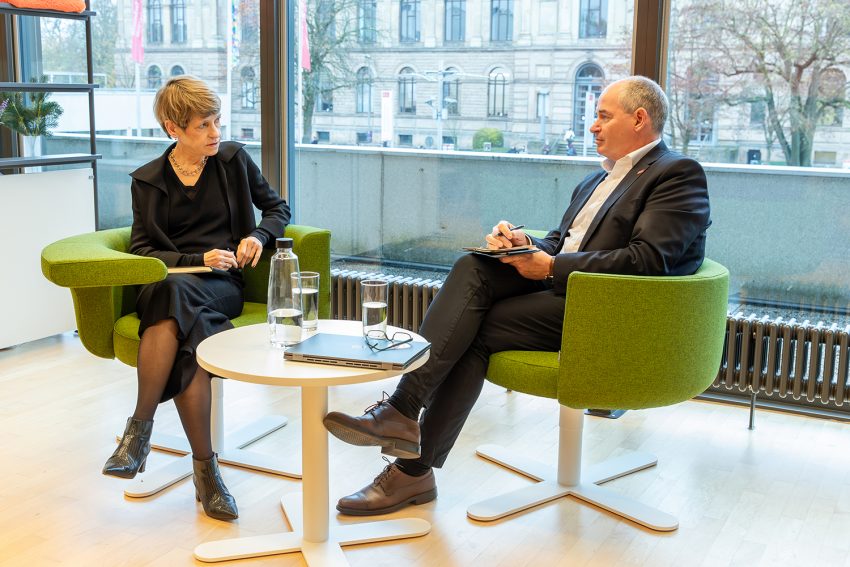How the “Langer Kamp 8” task force is working on solutions Interview with President Angela Ittel and Vice-President Dietmar Smyrek
A task force is set up when time is of the essence and complex tasks need to be completed quickly to prevent massive damage to the university and its staff. The aim of the task force is to combine expertise and organisational synergies to find faster and more efficient solutions than would be possible through standard organisational processes. The partial evacuation of the institute building at Langer Kamp 8 in Braunschweig is one such case. Here, a group was formed across many organisational units and institutes to ensure the continued operation of the facilities previously located there. We want to restore optimal working conditions as quickly as possible. TU President Angela Ittel and Dietmar Smyrek, Vice President for Human Resources, Finance and University Construction, provide an insight into the work of this task force.

President Angela Ittel and Dietmar Smyrek, Vice President for Human Resources, Finance and University Construction.
Photo credits: Kristina Rottig/TU Braunschweig
When it became clear that part of the institute building at Langer Kamp 8 would have to be evacuated, TU Braunschweig set up a task force in mid-August 2024. Now, after a good ten weeks of work, is a task force the right instrument?
Angela Ittel: Yes, a task force is essential in such a case in order to quickly bring together all the organisational units involved and to concentrate on finding solutions. In addition to the university management, the institutes that have their offices and laboratories at Langer Kamp 8, the Dean’s Office of the Faculty of Mechanical Engineering, the Staff Council, Facility Management, Human Resources, Occupational Safety and the Press and Communications Office are represented. We meet regularly, at least once a week. However, our meetings are not only about the implementation of the partial evacuation, but also about clarifying and preparing long-term solutions. Agreed tasks are processed and reviewed, needs are clarified, feedback from employees is recorded and communication with the trade supervisory authority is prepared.
What has happened since the task force started its work? What have you been able to achieve?
Dietmar Smyrek: The first thing we did was to get an overview of the number and size of the working groups housed in the building, as well as the use of the premises and research equipment (laboratories, offices). We then checked the requirements, specified the relocation plans and developed scenarios for the reaction of the trade supervisory authority. Our rapid solutions ensured that the ground floor and basement could continue to be used for five years under certain conditions. We were also able to rectify almost all of the identified defects very quickly, get the plumbing and fire alarm system up and running and improve fire safety. In addition, we were in direct contact with the management of Langer Kamp 8 on an almost weekly basis about our activities.
Why do solutions often take so long?
Angela Ittel: We have a very complex situation here. In order not to be taken by surprise – for example, by an overnight ban on access to the site – the task force decided early on in favour of a direct but planned partial evacuation. Nevertheless, replacement areas for research equipment and temporary workplaces, service providers and processes had to be found in the shortest possible time. And sometimes things move more slowly than desired. Friction is inevitable. However, one thing is certain: the entire task force is committed to the process – partial evacuation, short- and medium-term replacement, and plans for a possible new building. We are all trying to find the best possible short, medium and long-term solutions for the employees, but we are also dependent on delivery times and deadlines of specialised companies.
Even if we already had an option for a new building and the funding for it, it would take several years to complete, given the requirements of public construction. Even if we have a plan for where we will permanently house our colleagues, that does not mean that the excavators will be rolling in January. This is not to say that we are procrastinating. But there are many processes and regulations, as well as market conditions, that need to be taken into account in public construction projects and that take time.
We are, of course, aware that the situation is very challenging for everyone involved. I would therefore like to thank everyone who has worked with us to take on and tackle these important tasks.
Will a task force be set up for every renovation project from now on?
Dietmar Smyrek: It is common knowledge that many our older TU buildings are in need of renovation. The building management is responsible for the planning. A task force would not be the appropriate organisational instrument. We are also in very close contact with the Ministry of Science and Culture (MWK) to discuss solutions and options.
Angela Ittel: In this context, I would like to draw attention to a positive development. We have just celebrated the laying of the foundation stone for the new chemistry building here, opposite the BRICS. Three more foundation stone laying ceremonies will take place in the near future: the replacement buildings for Physics and Pharmacy, as well as the new building for battery research, the “Centre for Circular Production of Next Batteries and Fuel Cells” (CPC).
